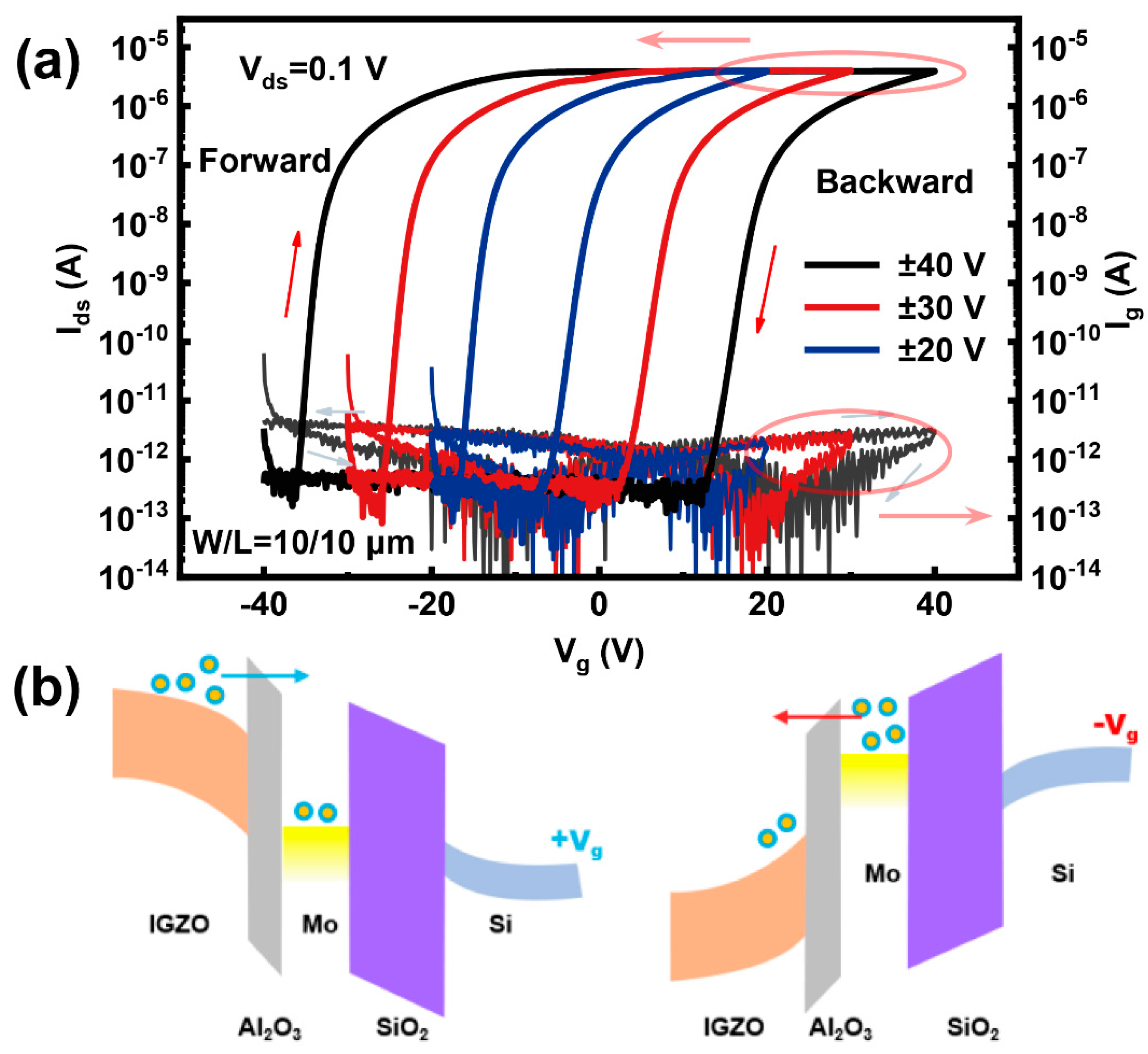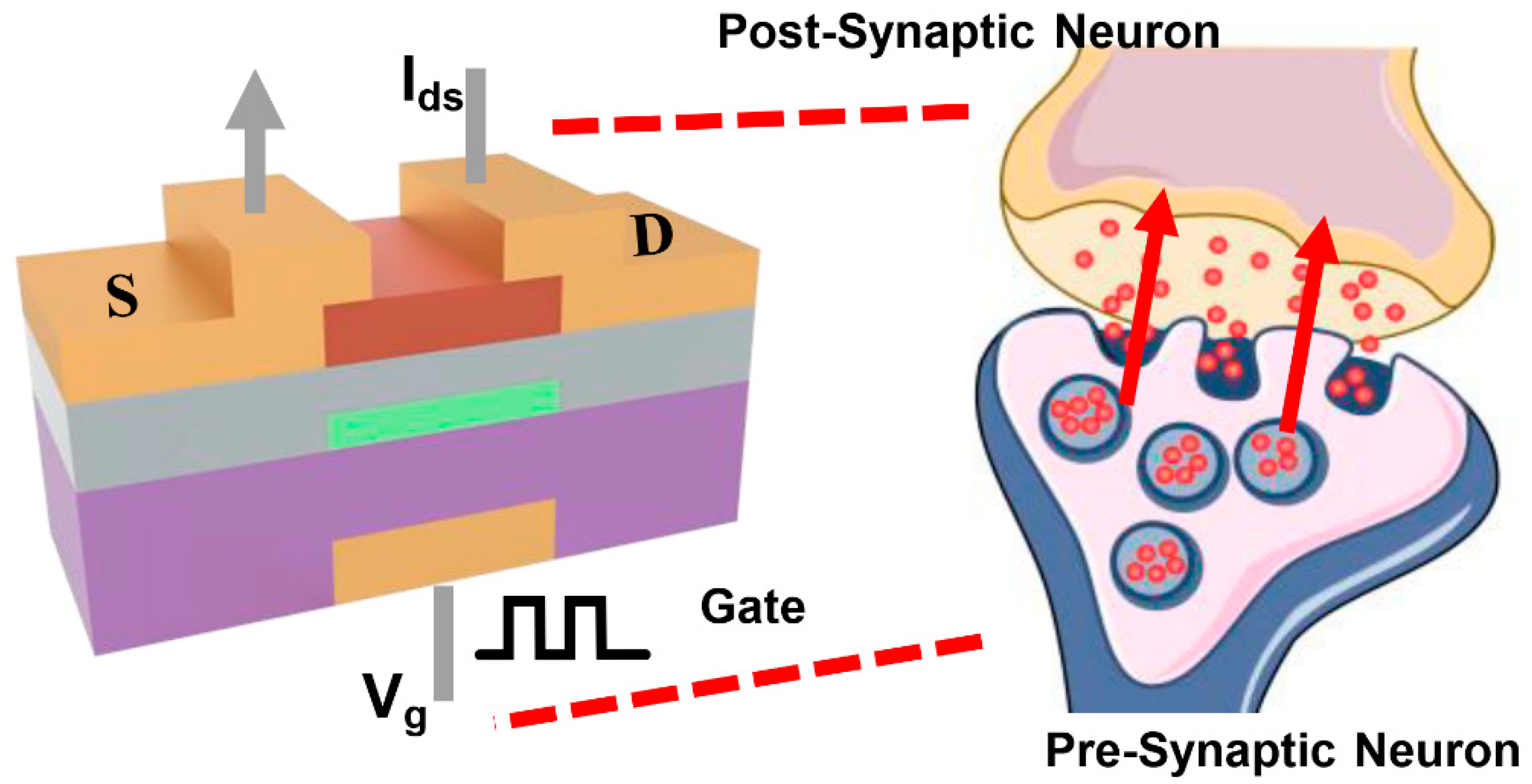Photonic–Electronic Modulated a-IGZO Synaptic Transistor with High Linearity Conductance Modulation and Energy-Efficient Multimodal Learning
Abstract
1. Introduction
2. Experiment
3. Results and Discussion
4. Conclusions
Author Contributions
Funding
Data Availability Statement
Conflicts of Interest
References
- Kim, Y.K.; Park, S.; Choi, J.; Park, H.; Jang, B.C. Low-power charge trap flash memory with MoS2 channel for high-density in-memory computing. Adv. Funct. Mater. 2024, 34, 2405670. [Google Scholar] [CrossRef]
- Liao, J.; Wen, W.; Wu, J.; Zhou, Y.; Hussain, S.; Hu, H.; Li, J.; Liaqat, A.; Zhu, H.; Jiao, L.; et al. Van der waals ferroelectric semiconductor field effect transistor for in-memory computing. ACS Nano 2023, 17, 6095–6102. [Google Scholar] [CrossRef] [PubMed]
- Liu, X.; Ting, J.; He, Y.; Fiagbenu, M.M.A.; Zheng, J.; Wang, D.; Frost, J.; Musavigharavi, P.; Esteves, G.; Kisslinger, K.; et al. Reconfigurable compute-in-memory on field-programmable ferroelectric diodes. Nano Lett. 2022, 22, 7690–7698. [Google Scholar] [CrossRef]
- Pazos, S.; Zhu, K.; Villena, M.A.; Alharbi, O.; Zheng, W.; Shen, Y.; Yuan, Y.; Ping, Y.; Lanza, M. Synaptic and neural behaviours in a standard silicon transistor. Nature 2025, 640, 1–8. [Google Scholar] [CrossRef] [PubMed]
- Chen, C.; Zhou, Y.; Tong, L.; Pang, Y.; Xu, J. Emerging 2D ferroelectric devices for in-sensor and in-memory computing. Adv. Mater. 2025, 37, 2400332. [Google Scholar] [CrossRef]
- Abbott, L.F.; Nelson, S.B. Synaptic plasticity: Taming the beast. Nat. Neurosci. 2000, 3, 1178–1183. [Google Scholar] [CrossRef]
- Prezioso, M.; Merrikh-Bayat, F.; Hoskins, B.D.; Adam, G.C.; Likharev, K.K.; Strukov, D.B. Training and operation of an integrated neuromorphic network based on metal-oxide memristors. Nature 2015, 521, 61–64. [Google Scholar] [CrossRef]
- Wang, Y.; Yin, L.; Huang, W.; Li, Y.; Huang, S.; Zhu, Y.; Yang, D.; Pi, X. Optoelectronic synaptic devices for neuromorphic computing. Adv. Intell. Syst. 2021, 3, 2000099. [Google Scholar] [CrossRef]
- Dai, S.; Zhao, Y.; Wang, Y.; Zhang, J.; Fang, L.; Jin, S.; Shao, Y.; Huang, J. Recent advances in transistor-based artificial synapses. Adv. Funct. Mater. 2019, 29, 1903700. [Google Scholar] [CrossRef]
- Yang, S.T.; Li, X.Y.; Yu, T.L.; Wang, J.; Fang, H.; Nie, F.; He, B.; Zhao, L.; Lü, W.; Yan, S.; et al. High-performance neuromorphic computing based on ferroelectric synapses with excellent conductance linearity and symmetry. Adv. Funct. Mater. 2022, 32. [Google Scholar] [CrossRef]
- Gosai, J.; Patel, M.; Liu, L.; Lokhandwala, A.; Thakkar, P.; Chee, M.Y.; Jain, M.; Lew, W.S.; Chaudhari, N.; Solanki, A. Control-etched Ti3C2Tx MXene nanosheets for a low-voltage-operating flexible memristor for efficient neuromorphic computation. ACS Appl. Mater. Interfaces 2024, 16, 17821–17831. [Google Scholar] [CrossRef] [PubMed]
- Ismail, M.; Mahata, C.; Kang, M.; Kim, S. Exploring conductance modulation and implementation of convolutional neural network in Pt/ZnO/Al2O3/TaN memristors for brain-inspired computing. Ceram. Int. 2023, 49, 19032–19042. [Google Scholar] [CrossRef]
- Wang, X.; Yang, H.; Li, E.; Cao, C.; Zheng, W.; Chen, H.; Li, W. Stretchable transistor-structured artificial synapses for neuromorphic electronics. Small 2023, 19, e2205395. [Google Scholar] [CrossRef]
- Ercan, E.; Hung, C.-C.; Li, G.-S.; Yang, Y.-F.; Lin, Y.-C.; Chen, W.-C. Molecular template growth of organic heterojunctions to tailor visual neuroplasticity for high performance phototransistors with ultralow energy consumption. Nanoscale Horiz. 2023, 8, 632–640. [Google Scholar] [CrossRef] [PubMed]
- Han, C.; Han, J.; He, M.; Han, X.; Wu, Z.; Yu, H.; Gou, J.; Wang, J. Photonic synaptic transistor with memory mode switching for neuromorphic visual system. Laser Photon- Rev. 2024, 18, 2300976. [Google Scholar] [CrossRef]
- Chen, X.; Chen, B.; Jiang, B.; Gao, T.; Shang, G.; Han, S.T.; Kuo, C.-C.; Roy, V.A.L.; Zhou, Y. Nanowires for UV-vis-IR optoelectronic synaptic devices. Adv. Funct. Mater. 2023, 33, 2208807. [Google Scholar] [CrossRef]
- Tang, J.; Yuan, F.; Shen, X.; Wang, Z.; Rao, M.; He, Y.; Sun, Y.; Li, X.; Zhang, W.; Li, Y.; et al. Bridging biological and artificial neural networks with emerging neuromorphic devices: Fundamentals, progress, and challenges. Adv. Mater. 2019, 31, e1902761. [Google Scholar] [CrossRef]
- Kim, M.J.; Park, H.J.; Yoo, S.; Cho, M.H.; Jeong, J.K. Effect of channel thickness on performance of ultra-thin body IGZO field-effect transistors. IEEE Trans. Electron Devices 2022, 69, 2409–2416. [Google Scholar] [CrossRef]
- Hung, M.P.; Wang, D.; Furuta, M. Investigating effect of postannealing time on positive bias stress stability of In–Ga–Zn–O TFT by conductance method. IEEE Trans. Electron Devices 2015, 62, 3697–3702. [Google Scholar] [CrossRef]
- Dutta, R.; Naqi, M.; Cho, Y.; Oh, J.; Kim, T.; Jeong, U.; Yu, Y.; Lee, Y.; Kim, S. Augmented optoelectronic quantum dot-enhanced heterogeneous IGZO-Te photodiode for artificial synaptic image processing applications. Adv. Funct. Mater. 2024, 34, 2315058. [Google Scholar] [CrossRef]
- Depas, M.; Vermeire, B.; Mertens, P.W.; Van Meirhaeghe, R.L.; Heyns, M.M. Determination of tunnelling parameters in ultra-thin oxide layer poly-Si/SiO2/Si structures. Solid-State Electron. 1995, 38, 1465–1471. [Google Scholar] [CrossRef]
- Yao, C.; Wu, G.; Huang, M.; Wang, W.; Zhang, C.; Wu, J.; Liu, H.; Zheng, B.; Yi, J.; Zhu, C.; et al. Reconfigurable artificial synapse based on ambipolar floating gate memory. ACS Appl. Mater. Interfaces 2023, 15, 23573–23582. [Google Scholar] [CrossRef] [PubMed]
- Kim, J.P.; Kim, S.K.; Park, S.; Kuk, S.-H.; Kim, T.; Kim, B.H.; Ahn, S.-H.; Cho, Y.-H.; Jeong, Y.; Choi, S.-Y.; et al. Dielectric-engineered high-speed, low-power, highly reliable charge trap flash-based synaptic device for neuromorphic computing beyond inference. Nano Lett. 2023, 23, 451–461. [Google Scholar] [CrossRef] [PubMed]
- Sun, C.; Zheng, Z.; Han, K.; Samanta, S.; Zhou, J.; Kong, Q.; Zhang, J.; Xu, H.; Kumar, A.; Wang, C.; et al. Temperature-dependent operation of InGaZnO ferroelectric thin-film transistors with a metal-ferroelectric-metal-insulator- semiconductor structure. IEEE Electron Device Lett. 2021, 42, 1786–1789. [Google Scholar] [CrossRef]
- Park, E.; Woo, D.Y.; Noh, G.; Jo, Y.; Lee, D.K.; Park, J.; Kim, J.; Jeong, Y.; Park, S.; Jang, H.J.; et al. IGZO charge trap flash device for reconfigurable logic functions. Appl. Phys. Lett. 2024, 124, 123501. [Google Scholar] [CrossRef]
- Park, E.; Jang, S.; Noh, G.; Jo, Y.; Lee, D.K.; Kim, I.S.; Song, H.-C.; Kim, S.; Kwak, J.Y. Indium-gallium-zinc oxide-based synaptic charge trap flash for spiking neural network-restricted boltzmann machine. Nano Lett. 2023, 23, 9626–9633. [Google Scholar] [CrossRef]
- He, Y.; Liu, R.; Jiang, S.; Chen, C.; Zhu, L.; Shi, Y.; Wan, Q. IGZO-based floating-gate synaptic transistors for neuromorphic computing. J. Phys. D Appl. Phys. 2020, 53, 215106. [Google Scholar] [CrossRef]
- Kwon, O.; Oh, S.; Park, H.; Jeong, S.H.; Park, W.; Cho, B. In-depth analysis on electrical parameters of floating gate IGZO synaptic transistor affecting pattern recognition accuracy. Nanotechnology 2022, 33, 215201. [Google Scholar] [CrossRef]
- Chen, F.; Zhang, S.; Hu, L.; Fan, J.; Lin, C.H.; Guan, P.; Zhou, Y.; Wan, T.; Peng, S.; Wang, C.; et al. Bio-inspired artificial perceptual devices for neuromorphic computing and gesture recognition. Adv. Funct. Mater. 2023, 33, 2300266. [Google Scholar] [CrossRef]
- Lee, S.U.; Kim, S.Y.; Lee, J.H.; Baek, J.H.; Lee, J.W.; Jang, H.W.; Park, N.G. Artificial synapse based on a δ-FAPbI3/atomic-layer-deposited SnO2 bilayer memristor. Nano Lett. 2024, 24, 4869–4876. [Google Scholar] [CrossRef]
- Li, L.; Shao, Y.; Wang, X.; Wu, X.; Liu, W.-J.; Zhang, D.W.; Ding, S.-J. Flexible femtojoule energy-consumption In-Ga-Zn-O synaptic transistors with extensively tunable memory time. IEEE Trans. Electron Devices 2019, 67, 105–112. [Google Scholar] [CrossRef]
- Bhadra, R.; Kumar, R.; Kumar, A. Device engineering of dual metal gate-based artificial synapse for enhanced plasticity utilizing Al2O3-based ion conducting electrolyte. IEEE Trans. Electron Devices 2024, 71, 2749–2754. [Google Scholar] [CrossRef]
- Lee, M.; Lee, W.; Choi, S.; Jo, J.W.; Kim, J.; Park, S.K.; Kim, Y.H. Brain-inspired photonic neuromorphic devices using photodynamic amorphous oxide semiconductors and their persistent photoconductivity. Adv. Mater. 2017, 29, 1700951. [Google Scholar] [CrossRef]
- Kim, M.K.; Lee, J.S. Synergistic improvement of long-term plasticity in photonic synapses using ferroelectric polarization in hafnia-based oxide-semiconductor transistors. Adv. Mater. 2020, 32, e1907826. [Google Scholar] [CrossRef]
- Ding, G.; Yang, B.; Chen, R.; Mo, W.; Zhou, K.; Liu, Y.; Shang, G.; Zhai, Y.; Han, S.; Zhou, Y. Reconfigurable 2D WSe2-based memtransistor for mimicking homosynaptic and heterosynaptic plasticity. Small 2021, 17, 2103175. [Google Scholar] [CrossRef]
- Dong, Z.; Hua, Q.; Xi, J.; Shi, Y.; Huang, T.; Dai, X.; Niu, J.; Wang, B.; Wang, Z.L.; Hu, W. Ultrafast and low-power 2D Bi2O2Se memristors for neuromorphic computing applications. Nano Lett. 2023, 23, 3842–3850. [Google Scholar] [CrossRef]
- Cho, H.; Lee, D.; Ko, K.; Lin, D.-Y.; Lee, H.; Park, S.; Park, B.; Jang, B.C.; Lim, D.-H.; Suh, J. Double-floating-gate van der Waals transistor for high-precision synaptic operations. ACS Nano 2023, 17, 7384–7393. [Google Scholar] [CrossRef]
- Cao, Y.; Meng, J.; Li, Q.; Wang, T.; Zhu, H.; Sun, Q.; Zhang, D.W.; Chen, L. An efficient training methodology of hardware neural network based on wafer-scale MoS2 synaptic array. Adv. Electron. Mater. 2022, 8, 2200909. [Google Scholar] [CrossRef]
- Wali, A.; Das, S. Two-dimensional memtransistors for Non-Von neumann computing: Progress and challenges. Adv. Funct. Mater. 2024, 34, 2308129. [Google Scholar] [CrossRef]
- Xu, Z.; Chen, G.; Chen, S.; Xu, H. Mimicking pain conditioning using an electrolyte-gated organic synaptic transistor. Adv. Mater. Technol. 2024, 9, 2302047. [Google Scholar] [CrossRef]







Disclaimer/Publisher’s Note: The statements, opinions and data contained in all publications are solely those of the individual author(s) and contributor(s) and not of MDPI and/or the editor(s). MDPI and/or the editor(s) disclaim responsibility for any injury to people or property resulting from any ideas, methods, instructions or products referred to in the content. |
© 2025 by the authors. Licensee MDPI, Basel, Switzerland. This article is an open access article distributed under the terms and conditions of the Creative Commons Attribution (CC BY) license (https://creativecommons.org/licenses/by/4.0/).
Share and Cite
Hou, Z.; Shen, J.; Zhong, Y.; Wu, D. Photonic–Electronic Modulated a-IGZO Synaptic Transistor with High Linearity Conductance Modulation and Energy-Efficient Multimodal Learning. Micromachines 2025, 16, 517. https://doi.org/10.3390/mi16050517
Hou Z, Shen J, Zhong Y, Wu D. Photonic–Electronic Modulated a-IGZO Synaptic Transistor with High Linearity Conductance Modulation and Energy-Efficient Multimodal Learning. Micromachines. 2025; 16(5):517. https://doi.org/10.3390/mi16050517
Chicago/Turabian StyleHou, Zhidong, Jinrong Shen, Yiming Zhong, and Dongping Wu. 2025. "Photonic–Electronic Modulated a-IGZO Synaptic Transistor with High Linearity Conductance Modulation and Energy-Efficient Multimodal Learning" Micromachines 16, no. 5: 517. https://doi.org/10.3390/mi16050517
APA StyleHou, Z., Shen, J., Zhong, Y., & Wu, D. (2025). Photonic–Electronic Modulated a-IGZO Synaptic Transistor with High Linearity Conductance Modulation and Energy-Efficient Multimodal Learning. Micromachines, 16(5), 517. https://doi.org/10.3390/mi16050517





